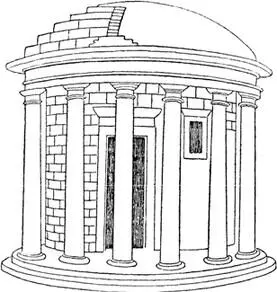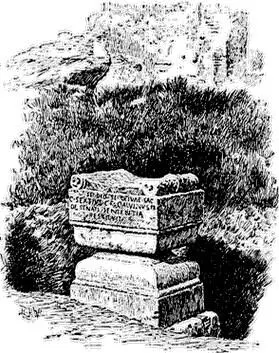Rodolfo Amedeo Lanciani - Pagan and Christian Rome
Здесь есть возможность читать онлайн «Rodolfo Amedeo Lanciani - Pagan and Christian Rome» — ознакомительный отрывок электронной книги совершенно бесплатно, а после прочтения отрывка купить полную версию. В некоторых случаях можно слушать аудио, скачать через торрент в формате fb2 и присутствует краткое содержание. Жанр: foreign_edu, История, История, на английском языке. Описание произведения, (предисловие) а так же отзывы посетителей доступны на портале библиотеки ЛибКат.
- Название:Pagan and Christian Rome
- Автор:
- Жанр:
- Год:неизвестен
- ISBN:нет данных
- Рейтинг книги:3 / 5. Голосов: 1
-
Избранное:Добавить в избранное
- Отзывы:
-
Ваша оценка:
- 60
- 1
- 2
- 3
- 4
- 5
Pagan and Christian Rome: краткое содержание, описание и аннотация
Предлагаем к чтению аннотацию, описание, краткое содержание или предисловие (зависит от того, что написал сам автор книги «Pagan and Christian Rome»). Если вы не нашли необходимую информацию о книге — напишите в комментариях, мы постараемся отыскать её.
Pagan and Christian Rome — читать онлайн ознакомительный отрывок
Ниже представлен текст книги, разбитый по страницам. Система сохранения места последней прочитанной страницы, позволяет с удобством читать онлайн бесплатно книгу «Pagan and Christian Rome», без необходимости каждый раз заново искать на чём Вы остановились. Поставьте закладку, и сможете в любой момент перейти на страницу, на которой закончили чтение.
Интервал:
Закладка:
When the farms of Isola Farnese and Vaccareccia, in which the remains of Veii and of its extensive cemeteries are situated, were sold, a few years ago, by the empress of Brazil to the marchese Ferraioli, the parties concerned agreed that the right of excavating and the objects discovered should belong to her, for a limited number of years, up to 1891, I believe. The first campaign, opened January 2, 1889, and closed in June, must be considered as one of the most valuable contributions to the study of Etruscan civilization which have been supplied of late to students, either by chance or by design. Had the empress been able to carry out her plans for two or three years more, the whole city and necropolis would have been explored, surveyed, and illustrated, in the most strictly scientific manner. Political events and the death of this noble woman brought the enterprise to a close. To come back, however, to the bed of votive objects in terra-cotta and bronze, I was able to make a rough estimate of its dimensions, which are two hundred and fifty feet in length, fifty feet in width, and from three to four in depth; nearly forty-four thousand cubic feet. The objects collected in two weeks number four thousand; the fragments buried again as worthless, double that number. The heads of veiled goddesses alone amount to four hundred and forty-seven, of which three hundred and seventy are full-faced, the rest in profile. The vein contains fifty-two varieties of types; to Bartoli's list, we must add busts, masks, arms, breasts, wombs, spines, bowels, lungs, toes, figures cut open across the breast and showing the anatomy, figures approximately human, or male and female embryos ending like the trunk of a tree with stumps corresponding to the feet, figures of hermaphrodites, human torsos modelled purposely without heads, arms without hands, legs without feet, hands holding apples or jewel-caskets, figurines of mothers nursing twins, beautiful life-sized statues of draped women, with movable hands and feet, rats, wild boars, sucking pigs, cows, rams, apples and other fruits, and "marbles."
The first structures dedicated to the gods in Rome were called aræ , and had the shape of a cube of masonry, in the centre of a square platform. They were modelled, in a measure, on the pattern of the Pelasgic hierones , in which the territory of Tibur and Signia is especially abundant. The aræ best known in Roman history and topography are six in number, namely, the ara maxima Herculis ; the Roma quadrata ; the ara Aii Locutii ; the ara Ditis et Proserpinæ ; the ara pacis Augustæ ; and the ara incendii Neroniani . The oldest of these were built of rough stones; those of later periods took the characteristic shape of the altar of Verminus, represented on page 52 of my "Ancient Rome," and of the altar raised to Vedjovis by the members of the Julian family, at Bovillæ, their birthplace, where it was found by the Colonnas in 1823. It is now in the villa of that family on the Quirinal. 40In imperial times the conventional shape was preserved, with the addition of two pulvini , or volutes, on the opposite edges of the cornice, as represented in the illustration on page 35 of "Ancient Rome" (a marble altar found at Ostia).
A Pelasgic hieron, or platform of altar, at Segni.

Round Temple of Hercules in the Forum Boarium.
The Ara Maxima Herculis. This altar, the oldest in Rome, was raised in memory of the visit of Hercules to our country. Tacitus and Pliny attribute its construction to Evander the Arcadian, forgetting that in prehistoric times the tract of land on which the altar stood, between the Forum Boarium and the Circus Maximus, was submerged by the waters of the Velabrum. It was at all events a very ancient structure, held in great veneration. Its rough shape and appearance were never changed, as shown by a precious—yet unpublished—sketch by Baldassarre Peruzzi which I found among his autographs in Florence. A round temple was built near the altar, in later times, of which we know two particulars: first, that it had a mysterious power of repulsion for dogs and flies; 41second, that it contained, among other works of art, a picture by the poet Pacuvius, next in antiquity and value to the one painted by Fabius Pictor, in the Temple of Health, in 303 b. c. 42The Temple of Hercules, the Ara Maxima, and the bronze statue of the hero-god were discovered, in a good state of preservation, during the pontificate of Sixtus IV., between the apse of S. Maria in Cosmedin (the Temple of Ceres), and the Circus Maximus. We have a description of the discovery by Pomponio Leto, Albertini, and Fra Giocondo da Verona; and excellent drawings by Baldassarre Peruzzi. 43
Except the bronze statue, and a few votive inscriptions, which were removed to the Capitoline Museum, everything—temple, altar, and platform—was levelled to the ground by the illustrious Vandals of the Renaissance.
The Roma Quadrata. According to the ancient ritual, the founder of a city, after tracing the sulcus primigenius or furrow which marked its limits, buried the plough, the instruments of sacrifice, and other votive offerings, in a round hole, excavated in the centre of the marked space. The round hole was called mundus , and its location was indicated by a heap of stones, which in course of time took the shape of a square altar. The mundus of ancient Rome was located in the very heart of the Palatine, in front of the Temple of Apollo, and the altar upon it was named the Roma Quadrata . This name has been much discussed, and it has even been applied to the Palatine city itself, although it is an established fact that there is, strictly speaking, no connection between the two. The controversy has been resumed lately by Professor Luigi Pigorini in a paper still unpublished which was read at the sitting of the German Institute, December 17, 1890; and by Professor Otto Richter in his pamphlet Die älteste Wohnstätte des römischen Volks , Berlin, 1891.
In view of the ignorance of ancient writers on this subject, and the almost absurd definitions they give of the word, we had come to the conclusion that the altar had been removed or concealed by Augustus, when he built the Temple of Apollo and the Portico of the Danaids, in 28 b. c. A remarkable inscription discovered September 20, 1890 (to which I shall refer at length later), by mentioning the Roma Quadrata as existing a. d. 204, shows that our opinion was wrong, and that the old altar, the most venerable monument of Roman history, had survived the vicissitudes of time, and the transformation of the Palatine from the cradle of the city into the palace of the Cæsars.
In December, 1869, when the nuns of the Visitation were laying the foundations of a new wing of their convent on the area of the Temple of Apollo, 44I saw a line of square pilasters at the depth of forty-one feet below the pavement of the Portico of the Danaids, and in the centre of the line a heap of stones, either of tufa or peperino, roughly squared. It is more than probable that, in 1869, I did not think of the Roma Quadrata, and of its connection with those remains, so deeply buried in the heart of the hill; but I am sure that a careful investigation of that sacred spot would lead to very important results.

Ara of Aius Locutius on the Palatine.
The Ara of Aius Locutius. In 1820, while excavations were proceeding near the western corner of the Palatine (at the spot marked No. 7, on the plan, page 106, of "Ancient Rome"), an altar was discovered, of archaic type, inscribed with the following dedication: "Sacred to a Divinity, whether male or female. Caius Sextius Calvinus, son of Caius, praetor, has restored this altar by decree of the Senate." Nibby and Mommsen believe Calvinus to be the magistrate mentioned twice by Cicero as a candidate against Glaucias in the contest for the praetorship of 125 b. c. They also identify the altar as (a restoration of) the one raised behind the Temple of Vesta, in the "lower New Street," in memory of the mysterious voice announcing the invasion of the Gauls, in the stillness of the night, and warning the citizens to strengthen the walls of their city. The voice was attributed to a local Genius, whom the people named Aius Loquens or Locutius. As a rule, the priests refrained from mentioning in public prayers the name and sex of new and slightly known divinities, especially of local Genii, to which they objected for two reasons: first, because there was danger of vitiating the ceremony by a false invocation; secondly, because it was prudent not to reveal the true name of these tutelary gods to the enemy of the commonwealth, lest in case of war or siege he could force them to abandon the defence of that special place, by mysterious and violent rites. The formula si deus si dea , "whether god or goddess," is a consequence of this superstition; its use is not uncommon on ancient altars; Servius describes a shield dedicated on the Capitol to the Genius of Rome, with the inscription: GENIO URBIS ROMÆ SIVE MAS SIVE FEMINA, "to the tutelary Genius of the city of Rome, whether masculine or feminine." The Palatine altar, of which I give an illustration, cannot fail to impress the student, on account of its connection with one of the leading events in history, the capture and burning of Rome by the Gauls, 390 b. c.
Читать дальшеИнтервал:
Закладка:
Похожие книги на «Pagan and Christian Rome»
Представляем Вашему вниманию похожие книги на «Pagan and Christian Rome» списком для выбора. Мы отобрали схожую по названию и смыслу литературу в надежде предоставить читателям больше вариантов отыскать новые, интересные, ещё непрочитанные произведения.
Обсуждение, отзывы о книге «Pagan and Christian Rome» и просто собственные мнения читателей. Оставьте ваши комментарии, напишите, что Вы думаете о произведении, его смысле или главных героях. Укажите что конкретно понравилось, а что нет, и почему Вы так считаете.












